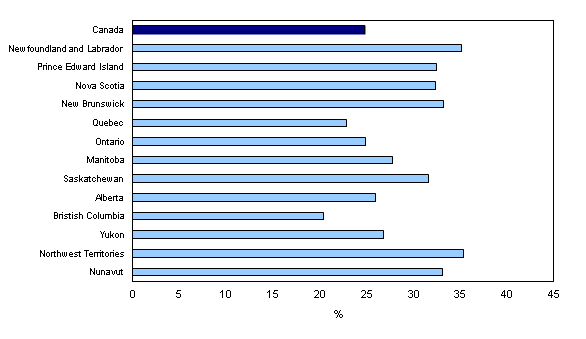Study: Adjusting the scales: Obesity in the Canadian population after correcting for respondent bias, 2011-2012
Archived Content
Information identified as archived is provided for reference, research or recordkeeping purposes. It is not subject to the Government of Canada Web Standards and has not been altered or updated since it was archived. Please "contact us" to request a format other than those available.
Released: 2014-05-28
In 2011-2012, one in four Canadian adults (6.3 million people) was obese, as defined by the body mass index (BMI), according to adjusted self-reported data.
Obesity, defined as having a BMI of 30 or greater, varies depending on what type of data is used to produce the estimate—self-reported or measured. In general, self-reported data underestimate the prevalence of obesity as people tend to under-report their weight and over-report their height. Therefore, this article presents self-reported obesity data that have been adjusted for these biases. These adjusted estimates have not been previously reported by Statistics Canada.
At the provincial level, British Columbia (20.4%) and Quebec (22.8%) had obesity levels lower than the Canadian average.
Meanwhile, at the health region level, lower than average obesity was found in Montréal, Toronto, York Region and southern British Columbia, where the three lowest estimates were found: Richmond (13.0%), North Shore/Coast Garibaldi (12.4%) and Vancouver (11.3%).
At an even smaller level of geography, census metropolitan areas (CMAs), similar trends were found. CMAs with obesity levels lower than average were located in British Columbia, Quebec and Ontario. As at the health region level, the three lowest estimates were all found in southern British Columbia: Kelowna (17.0%), Vancouver (17.4%) and Victoria (19.6%).
When multiple levels of geography were considered, the highest reported levels were found in Atlantic Canada and the Prairies. Higher than average levels of obesity were also noted in the territories and smaller CMAs in northern and southwestern Ontario.
Note to readers
This release presents data from the Canadian Community Health Survey (CCHS). During 2011 and 2012, data were collected from approximately 130,000 respondents aged 12 or older, residing in households, in all provinces and territories.
Data are available for 109 health regions or combined health regions across Canada. The CCHS is an ongoing survey that collects a wide range of information about the health status of Canadians, factors determining their health status, and their use of health care services.
Residents of Indian reserves, health care institutions, some remote areas, and full-time members of the Canadian Forces were excluded.
For more statistics and analysis on the health of Canadians and the health care system, visit the Health in Canada module. This module is accessible from our homepage, under Features.
The article "Adjusting the scales: Obesity in Canada after correcting for respondent bias," in Health at a Glance (Catalogue number82-624-X), is now available from the Browse by key resource module of our website under Publications.
Contact information
For more information, or to enquire about the concepts, methods or data quality of this release, contact us (toll-free 1-800-263-1136; 514-283-8300; infostats@statcan.gc.ca) or Media Relations (613-951-4636; statcan.mediahotline-ligneinfomedias.statcan@canada.ca).
- Date modified:


